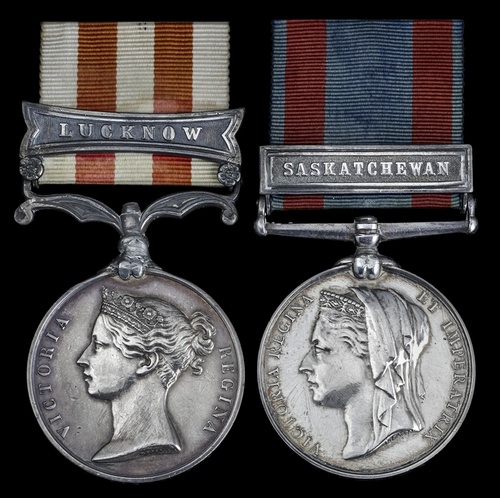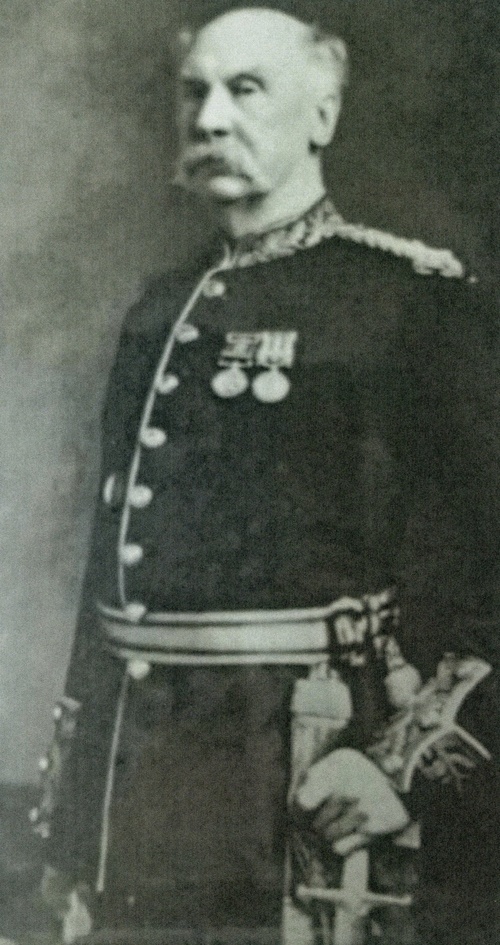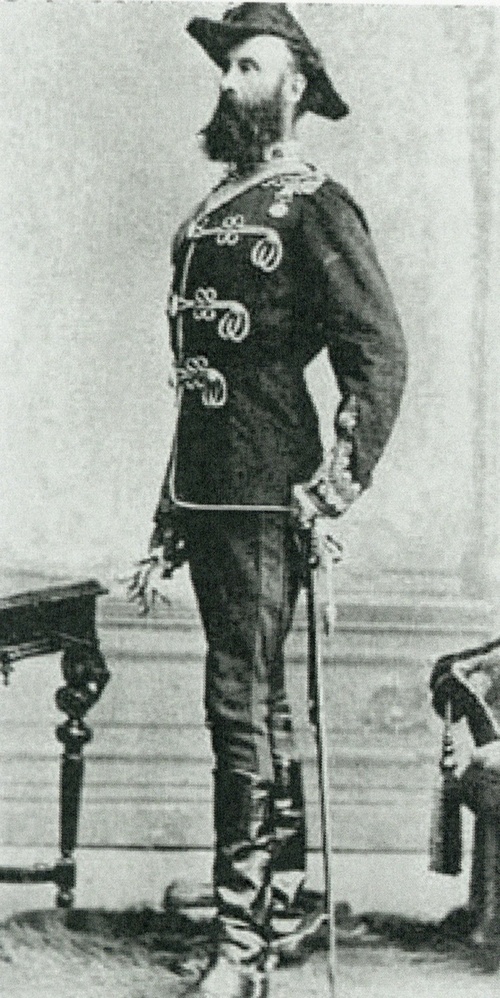Auction: 19001 - Orders, Decorations and Medals
Lot: 501
An outstanding Indian Mutiny and North-West Canada Campaign pair to Major-General T. B. 'Gunner Jingo' Strange, a most colourful officer who was considered the 'Father of the Canadian Artillery'; four times mentioned during the Indian Mutiny, he went on to Command the Alberta Field Force during the Riel Rebellion of 1885, his son, H. B. Strange, acting as his Aide-de-camp
Indian Mutiny 1857-59, 1 clasp, Lucknow (Capt. T. B. Strange. R. Arty.); North West Canada 1885, 1 clasp, Saskatchewan (Maj Genl. T. B. Strange Comd. Alba. Fd. Force), solder repair to suspension on first, now fixed, heavy edge bruise to first, very fine (2)
M.I.D. London Gazette 8 June 1858:
'Action at Agra.'
M.I.D. London Gazette 17 July 1858:
'For action with the Jounpore Field Force.'
M.I.D. London Gazette 17 September 1858:
'For defeat of the rebels near Nowabgunge (1858).'
M.I.D. London Gazette 31 January 1859:
'For action in the occupation of Sultapore & passage of the Goomtee (1858).'
'For action near Daodpore on the Lucknow Road (1858).'
One of 17 Medals issued to British Officers on the Staff in Canada.
Thomas Bland Strange was born on 15 September 1831 at Meerut, India, the second son of Henry Francis Strange. Educated at the Edinburgh Academy, a school rich in military history, he was later sent to the R.M.A. at Woolwich where he prepared for a career with the artillery.
He graduated and was commissioned on 17 December 1851, being soon afterwards posted to Gibraltar. In 1853 he was promoted 1st Lieutenant and ordered to Jamaica, despite his protestations to avoid this military backwater; to compound matters, Thomas contracted yellow fever that nearly cost his life - he attributed his survival to abstention from alcohol and meat - a regimen he maintained.
Upon recovery, Strange served briefly at Nassau before returning to England in 1856. With the outbreak of the Indian Mutiny at Meerut in May 1857, it wouldn't be long before Strange would be called to arms:
Arriving on 11 October 1857, he proceeded to Varanasi, the Headquarters for the suppression of the mutineers. As part of the first group of reinforcements, he likely witnessed some harrowing sights, such as those detailed in 1793-1870: An Expanding Empire, by author P. J. Marshall:
'Violence, which sometimes betrayed exceptional cruelty, was inflicted on both sides; on British Officers and civilians (including women and children) by the rebels, and on the rebels and their supporters (including entire villages) by British reprisals. The Cities of Delhi and Lucknow were laid waste in the fighting and during the British retaliation.'
It was at Lucknow that Strange began to make a name for himself and build a reputation for initiative and daring which would result in four 'mentions'; the most celebrated exploit involved using his own artillery battery as cavalry to charge and capture a rebel battery, a feat said to be unique in the history of the Royal Artillery. He continued to participate in the mopping-up operations until exhaustion brought on a severe attack of fever. He served in the Punjab for two more years, in 1861 taking six months leave for a solo walking tour through the Himalayas from Tibet of Kashmir. Surrounded by snow-capped peaks and lush green pastures, it was at Simla that he met his wife, Maria Elinor. Marriage and their first child, Harry Bland Strange, soon precipitated a return to England.
At Woolwich, Strange was appointed to the Instructional Staff and was clearly popular amongst the volunteers. On the other hand, a run-in with his superiors over his views on equipment, which found themselves published in The Times, left him in hot water. Nonetheless he was promoted Major in July 1871, despite declaring that he saw little hope of advancement in the peacetime army in an England where:
'…the little people at the top of the big Empire were bent on shrinking it, and the withdrawal of imperial garrisons was contemplated.'
The withdrawal of garrisons presented an opportunity. As the Colonies progressed towards self-government, taxpayers became increasingly reluctant to foot the bill. In 1866, Disraeli wrote:
'We must seriously consider our Canadian position which is most illegitimate. An army maintained in a country which does not permit us to govern it! What an anomaly! … What is the use of colonial deadweights which we do not govern?'
With the departure of the last British regular troops in 1871, the responsibility for the defence of Canada fell to the militia - yet their defeat at Ridgeway in 1866 revealed their weakness. As the British withdrew, the Canadian authorities maintained two batteries of artillery at Quebec and Kingston. Asking London for two suitable Commanding Officers, Strange duly accepted the command in September 1871 of Quebec and its School of Gunnery and promotion to Lieutenant-Colonel.
Made Inspector of Artillery and Warlike Stores in 1872, he organised Canada's first permanent military units. Training the militia gunners with skill, Strange moulded 'B' Battery into a force which was able to take responsibility for the Citadel. Together with 'A' Battery at Kingston, these two batteries formed the core of what was to become the Canadian Army. The units exist today as part of the Royal Canadian Horse Artillery.
Fluent in French, Strange found Quebec very much to his taste; he was an active member of the Literary and Historical Society of Quebec, organised the public centennial celebrations of the 1775 defeat of the Americans under Richard Montgomery, and also served as Master of the Stadacona Hunt. By 1881, Strange had achieved much happiness and status in Canada and numbered the Quebec Premier, Henri-Gustave Joly de Lotbiniere as a close friend. The G.O.C., Major-General Luard, praised him as:
'… the able and well known officer of the Royal Artillery, who has devoted ten of the best years of his life, and has been like a father, to the artillery of Canada…'
At the age of 50 years with nine years on secondment and thirty years of service, Strange was told that his time in the military was up. In 1882 he acquired a homestead and ranching lease east of Calgary and formed the Military Colonization Company of Canada Limited which was chartered the following year. His plan was to raise cavalry horses for the British Army and to use the ranch to train 'young Englishmen of good family in the art of stock raising'. Success was muted. Plagued by horse and cattle thieves from the nearby Blackfoot Indian Reserve, prairie fires and some 'amiable magistrates', he found himself purchasing a further 2000 head of cattle with a $30,000 mortgage.
For a man like Strange, the North-West rebellion which began in the Spring of 1885 was a fresh opportunity akin to that over a decade before at Quebec. Approached by the Minister of Militia and Defence, Adolphe-Philippe Caron, Strange readily accepted the role to organise the defence of Alberta and enthusiastically put together the Alberta Field Force out of 'three very green militia battalions along with a few mounted policemen and cowboys'. Over the next couple of weeks, and following the Frog Lake Massacre where nine settlers were killed, Strange attempted to mould his three militia units which included the 65th Mount Royal Rifles, the 9th Voltigeurs and the Winnipeg Light Infantry. Strange had worked well with French-Canadian units before and welcomed them.
On 20 April, Strange marched his Field Force to Edmonton and then down the North Saskatchewan River in search of the Cree under Big Bear. On 24 May his force reached the scene of the grisly massacre, where it paused long enough to bury the remains of those killed. Three days later, Inspector Sam Steele made contact with Indian forces near Fort Pitt. Strange brought up his forces, 224 men and one gun, but lacking information about the strength opposing him he decided against a frontal attack. Instead he shelled the Cree position until the risk of encirclement led to a controlled withdrawal. Strange's professional experience and memories of the Mutiny undoubtedly saved many lives.
On 3 June, Sam Steele and a small mounted force came across the Cree again, this time as they crossed a tributary of Loon Lake. After a brief exchange, both sides withdrew. This was the last engagement of the rebellion; Big Bear surrendered at Fort Carlton on 2 July.
The review of the Campaign was a complicated one. Whilst others received purses of up to $20,000 and honours appeared to abound, Strange received none of the public recognition he desired, despite his loud lobbying for a C.M.G.; his penchant for sarcasm probably did not help him in his quest. In a letter to the Canadian Prime Minister, Sir John A. Macdonald he wrote:
'I ask for no honour. I am already the most distinguished imperial officer that ever served in Canada - distinguished by not having been years ago given the distinction of three or four letters that have fallen to the lot of every officer of rank who has served Canada, from Colonel French to Colonel Hewett.'
Equally hurtful, the British Government stopped his pension because he had taken employment with a colonial government. It was later restored, but it came when Strange was struggling to rebuild and refinance his ranch. By September 1885, Strange's position had become largely untenable. In a letter from Edgar Dewdney, then Lieutenant-Governor of the North-West Territories, to Macdonald, the former wrote that he had decided to go to Blackfoot Crossing when the Governor General visited because…
'General Strange will probably be there if I was not and he would be a very red blanket in the eyes of Three Bulls, Crowfoot's warrior. They don't like him and I advised Oswald to get rid of the General or there would be trouble.'
As fate would have it, shortly after the rebellion a horse kicked Strange and broke his leg. It never healed properly and life on the ranch rapidly lost its lustre.
In 1888, Strange returned to England. He found new work touring the world as an agent for Hiram Maxim, selling the new machine gun which Maxim had invented. On his final return to England, he wrote his memoirs which were published as Gunner Jingo's Jubilee in 1893. A somewhat controversial read, the book settled old scores aplenty. It also revealed an intelligent, curious personality with a sense of irony.
In retirement, Strange lived in Ireland where he served as a magistrate. He returned to England during the Great War and in 1924 published, The Bombardier: the Father of the Canadian Artillery. Following the death of his first wife in 1917, Thomas Bland Strange married Janet Elizabeth Fell. He died on 9 July 1925 in Camberley, Surrey, his funeral attended by scores of Canadian dignitaries; sold with copied service record.
Subject to 20% VAT on Buyer’s Premium. For more information please view Terms and Conditions for Buyers.
Sold for
£24,000









